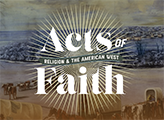



"America has set an example to mankind to think that a man may be of different religious sentiments from our own, without being a bad member of society. Some will be concerned that the people of America may, perhaps, choose representatives who have no religion at all, and that pagans and Mahometans [Muslims] may be admitted into offices. But how is it possible to exclude any set of men, without taking away that principle of religious freedom which we ourselves so warmly contend for?"
— Future Supreme Court Justice James Iredell, North Carolina Constitutional Convention, 1788